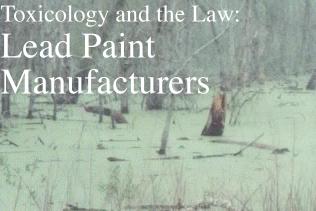 |
||||
Experts |
||



R.I. Jury Finds Lead Paint Manufacturers Responsible for Public Health Nuisance/Toxicity
What the jury found; what paint manufacturers will have to do in R.I.—and (possibly) in other states
The Jury Verdict/Background
A Rhode Island jury (1) found that three paint manufacturers (Sherwin-Williams, Millenium and NL Industries) created a public nuisance with leaded paint products. Specifically, the jury found: (a) the existence of conditions that cause unreasonable harm to the public, or the threat of such harm; and (b) that the defendants’ conduct or lack thereof created and/or maintained those conditions.
The verdict requires remediation of the 200, 000 to 300, 000 homes painted with lead-based paint, prior to 1978 (the year lead-based paint was banned); a public education program designed to improve consumers’ understanding of the problem and preventative measures that can be taken (beyond the remediation) to reduce risk; and regular blood testing of at-risk groups. This program is estimated to cost billions in R.I. and, given the state’s small size and the number of other communities and states considering similar actions, to have potentially huge implications for the paint manufacturers.
What are the conditions that created this public nuisance? Widespread flaking and deterioration of lead-based paint inside of homes produce lead-contaminated dust, and outside, lead-contaminated soil. Each of these lead-contaminated media can be subsequently ingested, primarily by young children, whose nervous systems are most vulnerable to the effects of lead, through hand-to-mouth activity, resulting in lead poisoning. There is also a recognized risk, albeit smaller, to older children and to adults.
Although lead-based paint has not been used for almost thirty years, flaking and deterioration of older homes remain significant sources of lead; and lead, once in soil, can persist for indefinite periods of time. Older structures, especially those built pre-1946, tend to be associated with the highest risk of lead poisoning in children(2); such structures predominate in R.I. and the northeast. It is estimated that in pre-1950’s homes, 25 percent of children 5 years of age or younger, have elevated blood lead (BPb)(3).
Defendants argued that the plaintiff (the state of R.I.) could not distinguish between leaded paint as a source of the lead versus leaded gasoline or lead emitted from manufacturing plants—the other main sources of environmental lead contamination—and so had no basis for arguing that the public nuisance and resultant toxicity occurred primarily from paint. The jury and court rejected this argument, indicating that whatever proportion of poisoning results from paint, that proportion is significant.
The jury concluded that the paint manufacturers had sufficient knowledge well before 1978 of lead toxicity and of the potential route of exposure in (young) children, but did nothing to address the problem or warn the public. Defendants are required to inspect, test and prioritize abatement of the potentially 200, 000 to 300, 000 lead-contaminated homes, and to set up a state-wide lead testing program for at-risk children, which includes those with prior elevated BPb, those from the lowest socioeconomic groups and those in pre-1978 constructed homes. Defendants are also required to provide public education to assist in identifying sources of lead contamination and preventing exposure before abatement is completed.
For a further discusssion of the potential neurotoxic effects of low level lead exposure, click here.
